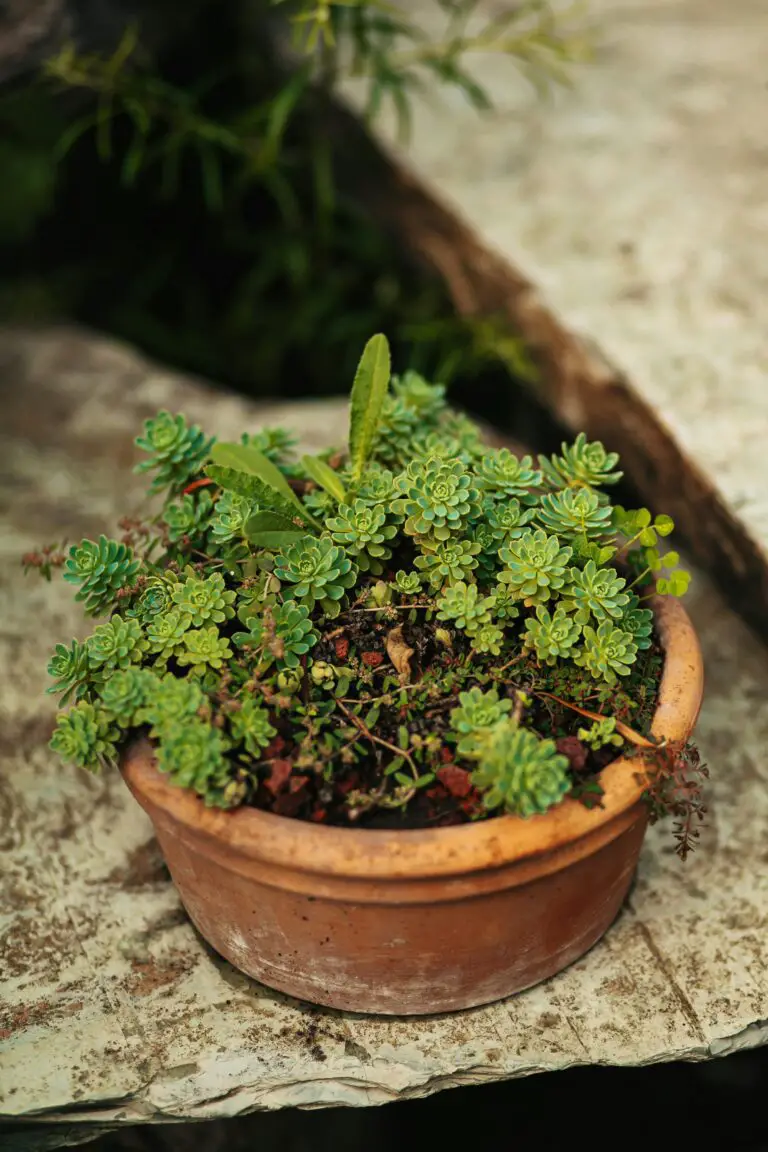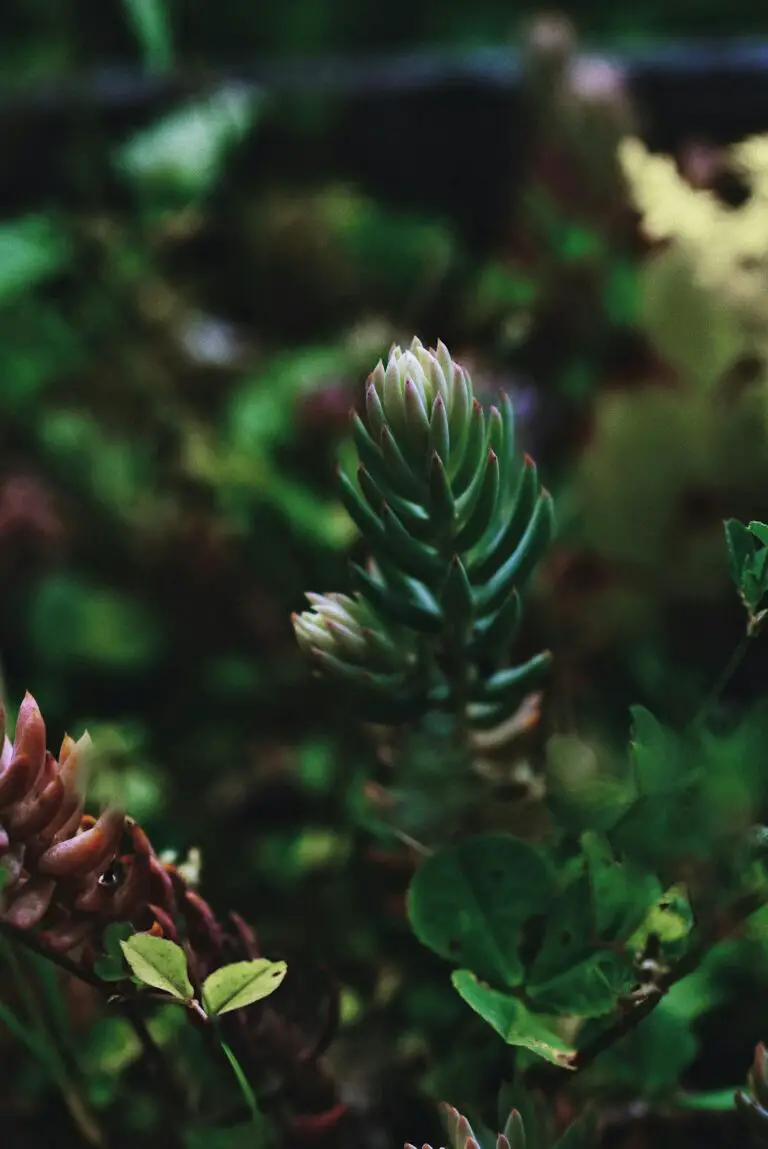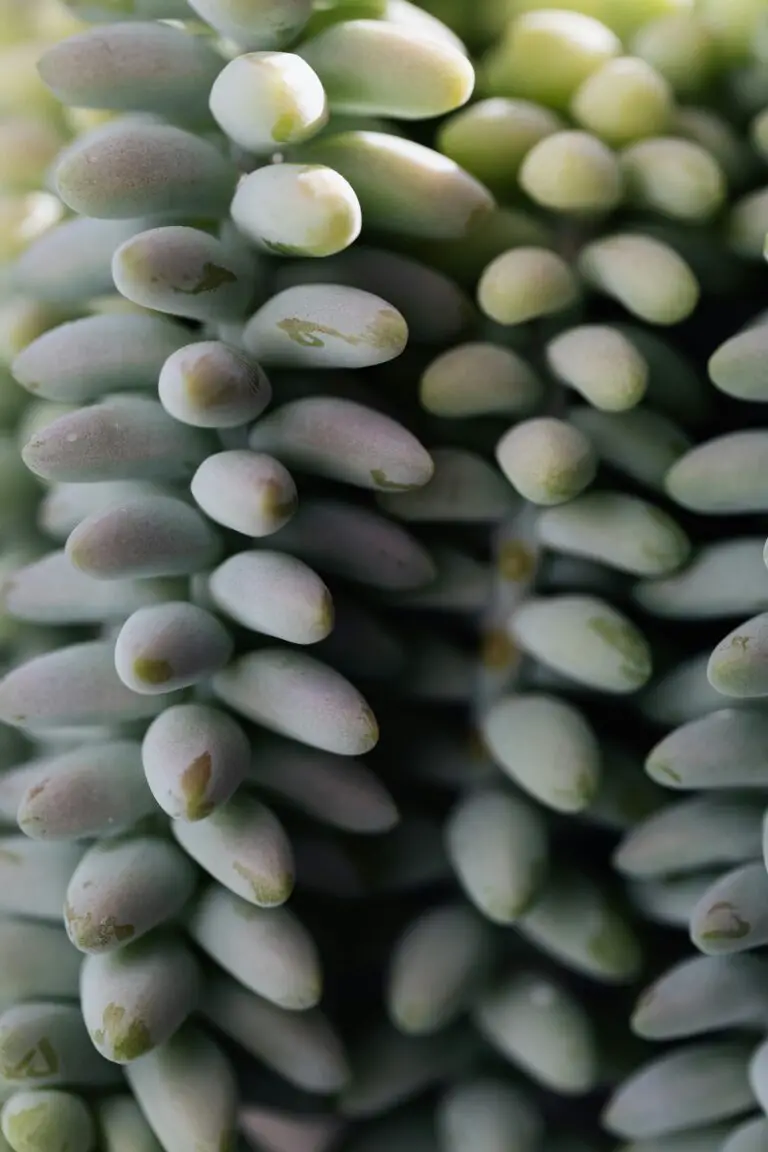Introduction to Sedums and Their Growing Habits
Ever wondered if your sedums need a little prop-up to stay prim and proper in your garden? Let’s delve into the world of these intriguing succulents and get to the root of their stature needs. Sedums, also fondly known as stonecrops, are a gardener’s gem, boasting an impressive portfolio of shapes, sizes, and colors. But it’s their growing habits that often stir the question: should sedums be staked?
Imagine a sedum plant, standing tall and proud, its clustered blooms beaming like tiny stars in a verdant sky. Now, that’s a picture-perfect garden scene, right? But not all sedums are the same, and while some may stand upright without a quiver, others might sprawl lazily across the ground like a sunbather on a beach towel. It’s this natural diversity in growth patterns that might nudge us towards giving our leafy friends a bit of a lift.

For example, take the ‘Autumn Joy’ sedum, known for its robust structure—it might surprise you by holding its blooms aloft without any assistance. However, its cousin, the ‘Matrona,’ may need a little nudge in the form of staking to prevent its heavy heads from flopping. Staking plants can be a simple yet delicate art, ensuring your garden’s beauties display their full glory without losing their natural grace.
Inspiration for staking can come from unexpected places, like the observation of a sedum in a rocky crevice, leaning confidently against a stone, as if it knew that a little support could mean the difference between thriving and merely surviving. That’s a lesson for us gardeners, pointing out that sometimes, a small intervention can lead to a thriving plant life.
Guiding our sedums to their best self doesn’t end with staking. There’s a plethora of succulent care tips that can elevate your garden to a succulent sanctuary, where each plant, whether staked or not, can bask in the glory of your thoughtful care. So, whether you choose to stake your sedums or let them roam free, understanding their unique habits is key to cultivating a garden that’s both beautiful and resilient.
To Stake or Not to Stake: Analyzing the Sedum’s Structure
When it comes to keeping our sedum plants standing tall and proud, we’re faced with a ‘stemmy’ dilemma: to stake or not to stake? That is the question troubling many succulent savants. Let’s dive in and dissect the upright posture of these succulents like a garden detective.
Sedum variations are as abundant as the stars in the sky, which means their structural integrity fluctuates. Picture the stout, robust sedum with its thick, fleshy stems anchoring it firmly like a natural-born bodybuilder, versus its more delicate cousins that wave in the breeze with the grace of a ballerina on tiptoe. There’s a whole spectrum of stem styles, from the gritty to the graceful!
Some sedums are Hercules in plant form; they don’t need the crutches of stakes. Take the popular ‘Autumn Joy’ variety – this champ stands on its own, flexing sturdy stems that laugh in the face of gravity. However, in the other corner of the ring, some tall, lanky varieties may start leaning like the Tower of Pisa when they’re top-heavy with blooms. And nobody wants a Leaning Tower of Sedum in their garden!
Assessing stem strength isn’t just about aesthetics, though let’s be honest – nobody’s dreaming of a slouchy sedum silhouette. It’s about the health of your plant too. A sedum taking a nosedive is prone to snapping stems and can become a VIP lounge for unwanted pests and diseases. That’s when staking becomes the superhero cape your sedum needs to stay upright and thriving.
Before you start staking willy-nilly, let’s press pause and ponder. It’s critical to gauge the individual needs of your sedum. Think about this: A little droop might actually be the charm your garden nook needs, letting nature take its course. But, if your sedum’s posture is more slump than slouch, giving it a helping hand with a stake might just be the TLC it requires.
Wondering how to provide the best care for these captivating succulents? Look no further than Sedum Whisperer: Articulating Care for Succulent Enthusiasts, our guide that will ensure your stonecrops are not just surviving, but thriving!
In the end, whether you stake your sedums or let them sway with the wind comes down to understanding their unique forms. Paying attention to their natural habits and providing the right support will ensure these garden gems continue to embellish your outdoor space with their sculptural beauty. Let’s keep our sedums standing tall, just as nature intended — or with a bit of help where needed!
The Pros and Cons of Staking Sedum Plants
Ever noticed how some sedum plants stand tall while others seem to enjoy a more relaxed sprawl across the garden bed? Staking might just be the invisible hand guiding this upright posture. But is it always the knight in shining armor for these succulent beauties?

Firstly, there’s an undeniable aesthetic appeal to a well-staked sedum. It’s like that well-polished gentleman at the garden party—structurally sound and dressed to impress. Stakes can prevent the awkward flopping over, especially for the sedum varieties that produce heavy blooms and seem to always be reaching out for support.
However, let’s not undermine sedum’s natural growth tendencies. These resilient succulents are designed to handle a bit of rough and tumble and often bounce back stronger from a bout of flopping around. It’s kind of like a life lesson, isn’t it? Sometimes, they need to bend to find their true strength, sans the crutch of stakes.
Now, if we’re talking plant health, stakes can be saviors or stiflers. They offer a hand to those high-top varieties, keeping fungi at bay by improving air circulation. Yet, for the low-growing sedums carpeting the earth, stakes may be more of a hindrance, disrupting their natural embrace of the ground and potentially leading to a stressed-out plant.
What we’re grappling with here is the heart of garden customization—knowing when to intervene and when to let Mother Nature play her hand. Should you feel your sedum is the kind that appreciates a shoulder to lean on, a gentle staking might just bring out the best in your plant. On the flip side, embracing the cascading or mounding demeanor of your sedum can lead to a lush, flowing aesthetic that’s uniquely seductive.
Consider this a conversation starter with your own green space. After all, each planting zone, sedum species, and individual plant may tell a different tale of staking success or au naturel splendor. It’s a dance of give and take, push and pull, stake or no stake.
Choosing the Right Support for Your Sedum
When it comes to nurturing your sedums, one question that often sprouts up is whether these succulent beauties need a little back-up to stand tall. The truth is, not all sedums require staking. But, for those that do, selecting the right support can be the difference between a flopped-over mess and an upright, proud display of lush foliage and vibrant blooms.
Imagine your sedums as the free-spirited performers of the plant world, with some varieties growing ambitiously towards the sky. Without adequate support, these aspiring stars could end up sprawled across the stage, looking more chaotic than charming. Now, you wouldn’t want your garden performance to be a clumsy ballet when it could be a well-choreographed symphony, right?

First and foremost, know your sedum. If you’ve got the low-growing types, they’re probably content hugging the ground like a green, leafy carpet. However, the taller variants, those are the divas of the succulent opera—they might just benefit from a prop or two. The trick is to choose a staking material that’s discreet yet sturdy, something that can hold up the star performers without stealing the show.
It’s a balancing act: opt for garden stakes that blend in with the natural hues of your greenery. Bamboo stakes, for example, are a fantastic choice. They merge seamlessly with your garden landscape, offering an organic lift to your sedums without the eyesore of shiny plastics or metals. And if you’re a fan of upcycling, old wooden dowels or even repurposed branches can turn into a DIY staking project that’s both functional and environmentally savvy.
What about the way you stake your sedums? Imagine guiding a vine gently along a trellis. That’s how you want to support your sedums—guiding their growth without choking their style. Use soft ties, like strips of old t-shirts or special velcro plant tapes, to secure them to the stakes. These ties should embrace the stems snugly but not too tight—think of it as a plant’s version of a comfy yoga pant.
Remember, the goal is to maintain your sedum’s natural grace, not to straitjacket it into an unnatural pose. With the right support, your sedums will stand tall, capturing the adoration they deserve, while you sit back and revel in the silent applause of a garden well-tended.
Staking Techniques: Best Practices and Common Mistakes
Ever watched a sedum plant in a wind storm? It does a frantic dance of survival, desperate for support. And that’s precisely why we’re wrapping our heads around the shoulds and should-nots of staking sedums. It’s not just about sticking a support next to your succulent and calling it a day; it’s an art form that, when mastered, can dramatically enhance your sedum’s vitality and aesthetic appeal.
Picture this: You’ve got a typically sturdy Autumn Joy sedum that’s beginning to slump under the weight of its own success – those heavy, bloom-laden heads. It’s an all-too-common scene and cries out for the need of proper staking. So, what’s the game plan? Let’s dive into a step-by-step guide that ensures your sedum stands tall without compromising its natural charm.
Step 1: Assess the necessity. Not every sedum requires staking. Low-growing varieties tend to hold their own, so only consider staking for taller types that are prone to flopping, especially when in full bloom.
Step 2: Choose your stake. Opt for natural materials like bamboo or wood that can blend seamlessly into your garden, providing support without the unsightly concert of plastic or metal sticks.
Step 3: The positioning of the stake is crucial; place it as close to the plant as possible without damaging the roots. You’re aiming for a secret service bodyguard vibe—there to support but not seen.
Step 4: Tie it up. Use soft materials like twine or strips of cloth to gently tether the sedum to the stake. This is no strangulation mission; make sure there’s room for the stem to breathe and grow.
Avoid common pitfalls: overtightening ties, staking too late in the season, or using a stake that’s too short, sending your sedum on a leaning tower escapade.
The result? A sedum that stands tall and proud, blooms reaching for the sky like botanical rockets. But stay vigilant! Regularly check your stakes and ties throughout the season to ensure they’re not causing any damage or constriction as your plant grows.
Let’s not forget that while staking can be a handy tactic, it’s not a fix-all. Poor soil conditions, overwatering, and lack of sunlight can all contribute to a sedum’s slouch. Address these issues, and you might find that your sedum can stand on its own after all.
And remember, your sedum’s well-being is at stake here – pun intended. So take the time to do it right, and your green companions will thank you with a spectacle of burgeoning blooms and resolute stems. Here’s a visual cue to guide you on your staking journey:

Embrace these guidelines with the finesse of a seasoned gardener, and watch as your sedum turns into the envy of the neighborhood, flaunting its newfound poise. Happy gardening!
Alternatives to Staking: Encouraging Strong Sedum Growth
Staking may seem like a go-to fix for supporting our beloved sedums, but it’s not the only pathway to robust, self-supporting plants. We’re delving into a world where stakes might become an adornment of the past. Let’s roll up our sleeves and uncover how a little foresight and savvy cultivation can result in naturally stout sedums.
Picture the perfect plot: well-draining soil that’s a haven for sedums. Preparing the correct foundation is like building a house; it determines the resilience of what’s to come. A strategic mix of grit, sand, and compost can provide a balance that ensures your succulents have strong roots—an essential trait for withstanding wind and weather without the crutch of stakes.

Moving on from the ground up, let’s chat about location. It can be tempting to plant your sedum in that oh-so-adorable nook by the fence, but if it’s not bathing in enough sunlight, it might just become a slouchy shadow of its potential. Full sun exposure encourages turgor in these plants, gifting them with firm stems that are more runway model than rag doll.
And finally, we’re a bit like matchmakers, but with plants—selective breeding is our dance. Crossing the sturdy with the stunning, enthusiasts and nurseries alike are coming up with varieties of sedums that are not just pretty faces, but resilient standouts in the succulent world. Through years of horticultural selection, we’re witnessing the birth of sedums that stand tall, sans stakes, emboldened by their very genetics.
So, the next time you reach for that bamboo stake, pause and consider: there might just be a better path to ensure your sedum garden is a testament to natural strength and beauty. By ardently focusing on soil prep, strategic placement, and smart breeding choices, we’re guiding our greens to a future where they stand proud and unaided.
In the Garden: Real-life Examples of Staked and Unstaked Sedums
As you dive deeper into the succulent world, you might wonder if your sedums need the extra support of staking. Let’s take a stroll through the gardens of seasoned plant enthusiasts and see the difference first-hand.
Unstaked Sedums Spreading Their Wings: Picture this: a sprawling groundcover of Sedum reflexum, its verdant leaves creating a lush carpet in Jane’s seaside garden. Jane prefers her sedums unconfined, allowing them to naturalize freely. The result? A breathtaking expanse that mirrors the wild beauty of the coast. No stakes here—just the sedum’s innate tendency to cascade and conquer.

Staked Sedums Standing Tall: Meanwhile, in Greg’s urban sanctuary, his prized sedums are reaching skyward, thanks to discreet staking. He argues that staked sedums, especially the statuesque Sedum telephium, stand with a poise that commands attention. With the support, these upright sedums form a living sculpture that thrives amid the city’s concrete and steel backdrop.
But not everyone’s sedum story is so black-and-white. Lisa, an experimental gardener, has played with both tactics. She shares anecdotes of her staked ‘Autumn Joy’ sedums, which, with the aid of bamboo rods, resist the toppling effect of heavy rain. Yet, she’s equally fond of her unstaked ‘Dragon’s Blood’ spillers that edge her garden paths, creating a vibrant tapestry of texture without any support.
As compelling as these stories are, they all echo a single truth: whether staked or unstaked, sedums exhibit a remarkable adaptability. Each gardener’s approach is a testament to their personal aesthetics and practical considerations—showing us there’s no one-size-fits-all answer to perfect succulent care.
Frequently Asked Questions
When it comes to the lush, fleshy leaves of sedums, gardeners often wonder about the nuances of care, particularly whether these robust succulents need the extra support of stakes. Imagine a sedum’s stems reaching skywards, heavy with blooms, only to take a topple in the brisk embrace of an early autumn breeze. That sight alone can stir the question: should sedums be staked? Let’s delve into the common queries that might spring up in a gardener’s mind.

When is the Best Time for Staking Sedums?
Periodically staked sedums are like toddlers with training wheels: they’re just learning the ropes of standing firm. The perfect time to introduce a stake is early in the growing season. As the plant elongates, gently tie it to the stake. Doing it early reduces the stress on the plant and helps maintain an upright growth habit, ensuring that your sedums aren’t caught off-guard by their own lushness.
How Can You Tell If a Sedum Requires Staking?
Not all sedums dream of climbing; many are quite content hugging the ground. The necessity of staking generally pertains to the taller, top-heavy varieties. An example: watching the ‘Autumn Joy’ sedum strain under the weight of its own ambition—that’s your cue. If the stems begin to sprawl or bend, they’re sending you an S.O.S. It’s like seeing a friend struggling with a heavy load; you wouldn’t hesitate to lend a hand, right?
Tips for Maintaining Staked Sedums
Maintaining staked sedums is akin to nurturing a close friendship. As the stems grow, check the ties—make sure they’re snug but not suffocating. Like a hug that’s just right, it should offer support without constraint. Use materials that won’t damage the plant, such as soft twine or cloth. And remember, your staked sedum could get top-heavy; a stake driven securely into the ground will be its steadfast ally against those gusty winds that might try to knock it down.
Signs of a Happy, Supported Sedum
A staked sedum standing tall is a vision of botanical triumph. You’ll see a marked difference in its posture, resembling a green sentinel in your garden. Flower heads will be elevated, proudly displaying their colors rather than shamefully bowing towards the ground. It’s not just about support; it’s about showcasing the plant’s best features, allowing it to thrive and contribute its full beauty to your garden symphony.



